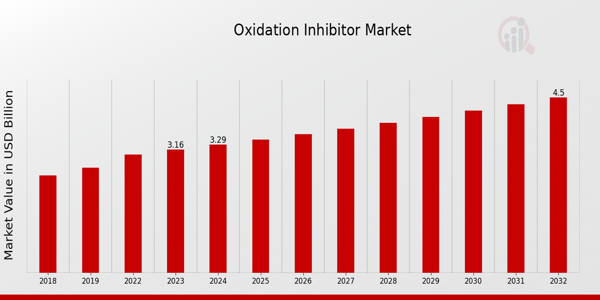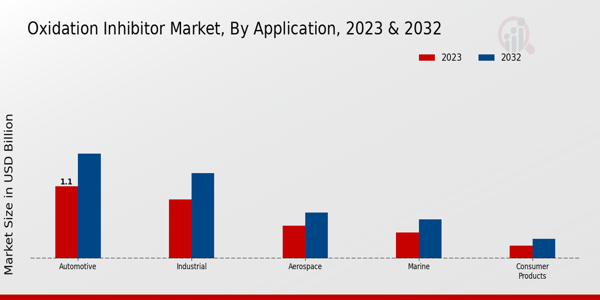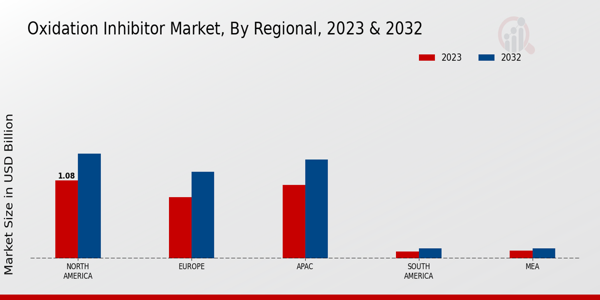Global Oxidation Inhibitor Market Overview
The Oxidation Inhibitor Market Size was estimated at 3.42(USD Billion) in 2024. The Oxidation Inhibitor Industry is expected to grow from 3.56(USD Billion) in 2025 to 5.07(USD Billion) by 2034. The Oxidation Inhibitor Market CAGR (growth rate) is expected to be around 4.0% during the forecast period (2025 - 2034).
Key Oxidation Inhibitor Market Trends Highlighted
Several drivers have been identified as core growth factors for the Oxidation Inhibitors Market. One of the leading growing trends is the rising consumption of oxidation inhibitors in the field of lubricants, coatings, fuels and many more. Growing this tendency is the demand that appeared in various industries for better quality and longer-lasting products. Furthermore, the increasing concern about the quality and performance of the products, especially in the automotive and aerospace industries, also drives the market demand for oxidation inhibitors. In addition, the market's need for environmentally friendly products is also being satisfied, as the demand for biodegradable oxidation inhibitors is constantly increasing.
The Oxidation Inhibitor Market is influenced by several key drivers that promote growth. One of the primary factors is the increasing demand for oxidation inhibitors in the manufacturing of various products, such as lubricants, coatings, and fuels. This trend is driven by the need to enhance the longevity and performance of products in diverse industries. Additionally, the rising awareness regarding product quality and performance, particularly in automotive and aerospace sectors, fuels the demand for effective oxidation inhibitors. Also, the trend towards eco-friendly and sustainable solutions is growing, leading to an increase in the formulation of biodegradable oxidation inhibitors, fulfilling the market's requirements for compliance with environmental regulations.Opportunities exist in the development of innovative formulations and technologies, particularly in the bio-based segment of oxidation inhibitors. As companies invest in research and development, they can capture market share by offering advanced solutions that meet specific customer needs. Furthermore, emerging markets present significant growth potential, as industrialization and infrastructure development continue to rise. Companies can explore collaborations and partnerships to expand their reach and improve product offerings, tapping into a broader consumer base. Recent trends include a shift towards using green chemistry principles in oxidation inhibitor development to meet rising environmental concerns.The demand for specialty chemicals is increasing, driving the modification of existing products and the creation of new ones that deliver better performance while also being environmentally friendly. The market acknowledges the need for more resilient and safer products, reflecting a holistic approach to product development. As a result, staying ahead in terms of innovation and aligning with sustainability efforts is becoming crucial for companies in this evolving landscape. Overall, the combination of these dynamics shapes the future of the Oxidation Inhibitor Market.

Source: Primary Research, Secondary Research, MRFR Database and Analyst Review
Oxidation Inhibitor Market Drivers
Increasing Demand for High-Performance Industrial Applications
The Oxidation Inhibitor Market Industry is witnessing a surge in demand for high-performance materials across various industrial applications. As industries such as automotive, aerospace, and electronics continue to evolve, there is an increasing necessity for formulations and products that can withstand extreme conditions and maintain their integrity over time. Oxidation inhibitors play a critical role in extending the life of these products, preventing deterioration through oxidation processes that can compromise quality and functionality.For instance, in the automotive sector, oxidation inhibitors are crucial for enhancing the durability of engine oils, lubricants, and coolants, thereby improving vehicle performance and reliability. Moreover, advancements in technology and the rise of innovative manufacturing processes necessitate the integration of oxidation inhibitors into a wide range of products to ensure compliance with industry standards and consumer expectations. As manufacturers increasingly prioritize quality and performance in their offerings, the demand for oxidation inhibitors is set to rise, contributing significantly to the growth of the Oxidation Inhibitor Market.Additionally, the trend towards sustainability and environmentally friendly formulations is also influencing product development within this market. Companies are investing in research and development to create greener oxidation inhibitors that do not compromise performance, opening up new opportunities for growth and innovation. Consequently, as the landscape of high-performance industrial applications continues to broaden, the demand for effective oxidation inhibitors is expected to follow suit, driving substantial growth within the Oxidation Inhibitor Market Industry.
Growing Awareness of Product Quality and Longevity
As consumers become more quality-conscious, there is an increasing awareness of the impact of oxidation on product longevity. The Oxidation Inhibitor Market Industry is benefiting from this trend, as manufacturers seek to improve the durability and effectiveness of their products. This heightened focus on quality leads to a higher demand for oxidation inhibitors, which can significantly prolong the lifespan of various materials and formulations.The trend is evident across numerous sectors, including adhesives, coatings, and plastics.
Advancements in Chemical Research and Development
Ongoing advancements in chemical research and development are propelling the Oxidation Inhibitor Market Industry forward. Research initiatives are focused on improving the efficacy and formulation of oxidation inhibitors, leading to the introduction of new and more effective products. This innovation enables manufacturers to introduce improved solutions that meet specific industry needs, thus expanding the market reach.
Oxidation Inhibitor Market Segment Insights:
Oxidation Inhibitor Market Application Insights
The Oxidation Inhibitor Market, with a revenue forecast of 3.16 USD Billion in 2023, showcases a diverse array of applications crucial to various industries. The Application segment is crucial in understanding how oxidation inhibitors function to prolong the lifespan of products in multiple sectors. Automotive applications heldold a significant market position, valued at 1.1 USD Billion in 2023 and projected to reach 1.6 USD Billion by 2032, reflecting its dominant role driven by increasing automotive production and the necessity for enhanced fuel efficiency and engine protection against oxidation.Following closely is the Industrial segment, valued at 0.9 USD Billion this year, expected to grow to 1.3 USD Billion in the next decade due to rising industrial activities and the demand for machinery longevity, highlighting the importance of oxidation inhibitors in lubricants and coatings that protect equipment from wear and corrosion. The Aerospace application, though smaller, contains significant implications, with a market valuation of 0.5 USD Billion in 2023, projected to increase to 0.7 USD Billion by 2032; this growth stems from stringent regulations surrounding aircraft performance and the need for materials that resist oxidation at high altitudes.The Marine sector contributes a value of 0.4 USD Billion, increasing to 0.6 USD Billion, as oxidation inhibitors play a vital role in protecting vessels against the harsh marine environment, underscoring their utility in maintaining the durability and reliability of maritime applications. Finally, Consumer Products have a relatively lower market presence at 0.2 USD Billion, with an expected rise to 0.3 USD Billion, revealing a growing trend where oxidation inhibitors are being integrated into household and personal care products to enhance shelf life and effectiveness.Overall, the application of oxidation inhibitors across these segments highlights the increasing awareness and necessity for materials that ensure longevity and performance, thereby driving the market growth and providing diverse opportunities for expansion across different industries. Each segment illustrates a unique contribution to the overall market dynamics, reflecting both existing needs and future trends to be anticipated in the Oxidation Inhibitor Market industry.

Source: Primary Research, Secondary Research, MRFR Database and Analyst Review
Oxidation Inhibitor Market Type Insights
The Oxidation Inhibitor Market is expected to experience notable growth, reaching a valuation of 3.16 USD Billion by 2023. The market's segmentation by Type reveals a diverse range of oxidation inhibitors, including Phenolic Compounds, Amine-Based Inhibitors, Metal Deactivators, and Multifunctional Additives. Each of these types plays a crucial role in preventing the degradation of materials and extending product lifespans. For instance, Phenolic Compounds are widely regarded for their exceptional thermal stability and antioxidant properties, making them prominent in various industrial applications.Meanwhile, Amine-Based Inhibitors are vital for safeguarding against oxidation in fuels and lubricants, thereby enhancing performance and reliability. Metal Deactivators help in mitigatingmitigate the catalytic effects of metals during oxidation, ensuring better product quality. Multifunctional Additives have gained significance due to their ability to provide multiple protective functions within a single formulation, catering to the growing demand for efficiency in applications. Overall, the trends indicate an increasing focus on these chemical solutions driven by advancements in technology, environmental regulations, and the need for sustainable solutions, all contributing to the favorable Oxidation Inhibitor Market statistics and driving market growth.
Oxidation Inhibitor Market End End-Use Insights
The Oxidation Inhibitor Market is experiencing notable growth driven by various end-use applications. In 2023, the market has shown a strong valuation of 3.16 billion USD, which is expected to grow to around 4.5 billion USD by 2032. Key segments such as lubricants, fuel additives, coatings, and plastics play critical roles in this growth. Lubricants, especially, are vital as they require oxidation inhibitors to enhance their performance and lifespan, thus dominating a significant portion of the market. Fuel additives are also crucial, as they improve fuel stability and efficiency, making them indispensable in automotive and industrial applications.Coatings benefit from oxidation inhibitors by providing enhanced durability and resistance to environmental factors, which is increasingly important in various industry sectors. Plastics also represent a major part of the market since they need oxidation inhibitors to maintain integrity and longevity, especially in outdoor applications where UV exposure is prevalent. Overall, these applications underscore the importance of oxidation inhibitors in ensuring product quality and longevity within the Oxidation Inhibitor Market.
Oxidation Inhibitor Market Product Form Insights
In 2023, the Oxidation Inhibitor Market was valued at 3.16 Billion USD, showcasing the importance and demand for oxidation inhibitors across various industries. The market segmentation by Product Form reveals three primary categories: Liquid, Solid, and Powder. Liquid forms are widely favored for their ease of application and versatility, playing a critical role in lubrication and preservation processes. Solid forms often provide superior stability and are extensively used in industries needing prolonged shelf life. The Powder form is significant for its concentrated nature, facilitating transportation and storage, thus appealing to sectors requiring efficient packaging solutions.The growth in these Product Form categories is driven by increasing industrial activities and advancements in formulation technologies. Nevertheless, the market faces challenges such as stringent environmental regulations and the need for sustainable practices. Opportunities lie in innovation within product formulations and expanding applications in emerging markets, contributing to the overall growth of the Oxidation Inhibitor Market industry. As consumer awareness increases, the demand for high-quality oxidation inhibitors across various formulations is expected to shape future market trends.
Oxidation Inhibitor Market Regional Insights
The Oxidation Inhibitor Market is showing considerable growth across various regions, with the overall market valued at approximately 3.16 USD Billion in 2023. North America is a prominent region, holding a valuation of 1.08 USD Billion in 2023, and is expected to grow significantly, reflecting its majority holding in the market due to advanced industrial applications. Europe follows closely with a valuation of 0.85 USD Billion, showcasing a significant increase as industries continue to invest in oxidation management solutions. The APAC region also plays a critical role, valued at 1.02 USD Billion, driven by booming manufacturing sectors that require effective oxidation inhibitors.In contrast, South America and MEA are comparatively smaller markets, valued at 0.1 USD Billion and 0.11 USD Billion, respectively, in 2023, highlighting niche applications and emerging growth opportunities. With a push towards sustainability and product longevity, the demand for oxidation inhibitors is expected to rise, particularly in regions with rapid industrialization and stringent environmental regulations. This overall regional segmentation supports the ongoing trend of increasing investments in the Oxidation Inhibitor Market, indicating the potential for further market growth.
 Source: Primary Research, Secondary Research, MRFR Database and Analyst Review
Source: Primary Research, Secondary Research, MRFR Database and Analyst Review
Oxidation Inhibitor Market Key Players and Competitive Insights:
The Oxidation Inhibitor Market is characterized by a dynamic competitive landscape where companies are constantly evolving to meet the needs of diverse industries such as automotive, aerospace, marine, and others. These inhibitors play a crucial role in preventing oxidation in various applications by prolonging the life of products such as lubricants, fuels, and polymers. The market is influenced by several factors including the increasing demand for high-performance materials, stricter environmental regulations, and the need for improved durability in productsSeveral factors, including the increasing demand for high-performance materials, stricter environmental regulations, and the need for improved durability in products, influence the market. In this competitive environment, companies strive to enhance their product offerings through innovation, strategic partnerships, and expansions into emerging markets. Analyzing the key players in this market reveals their strategies, market shares, and areas of specialization, which contribute to their competitive positioning.Chemtura is a strong player in the Oxidation Inhibitor Market and is known for its robust portfolio of chemical solutions aimed at various applications. The company has established a significant market presence by leveraging its advanced technologies and extensive research initiatives focused on developing high-quality oxidation inhibitors. Chemtura's strengths lie in its long-standing expertise in chemical formulations and its commitment to sustainability, which resonates with the growing demand for environmentally friendly products. The company also emphasizes customer collaboration, enabling it to tailor solutions that meet specific industry requirements. This adaptive approach not only enhances customer satisfaction but also aids in solidifying the company's position as a reliable supplier in the market.Sabic adds to the competitive landscape of the Oxidation Inhibitor Market with its innovative and diverse range of chemical products engineered for performance. Renowned for its technological prowess, Sabic invests significantly in research and development, which propels its capabilities in creatingto create cutting-edge oxidation inhibitors. The company's strengths reflect its strong footprint allowing it to effectively serve a wide variety of sectors, thereby capturing substantial market shares. Sabic is also recognized for its commitment to sustainability and capability of providing safe, efficient products that meet stringent regulations. This focus on innovation and sustainability not only distinguishes Sabic from its competitors but also underscores its positioning as a leader in the oxidation inhibitor segment of the market.
Key Companies in the Oxidation Inhibitor Market Include:
Oxidation Inhibitor Market Industry Developments
Recent developments in the Oxidation Inhibitor Market have seen significant movements among key players such as Chemtura, Sabic, 3M, and Eastman Chemical Company. The industry is experiencing a surge in demand for oxidation inhibitors, primarily due to their applications in various sectors, including automotive, aerospace, and industrial manufacturing. Momentive Performance Materials and Evonik Industries have also been innovating their product lines to enhance performance characteristics, driving market growth. In terms of mergers and acquisitions, AkzoNobel has been actively pursuing strategic alignments to expand their its portfolio in oxidation inhibitors, while The Dow Chemical Company has recently announced plans to acquire a tech firm that specializes in sustainable chemical solutions, signaling an industry trend towards eco-friendly applications. BASF's recent partnerships aim to enhance research in oxidation inhibitors, reflecting the competitive landscape's focus on innovation and sustainability. Furthermore, Clariant and Huntsman Corporation are reporting notable increases in market valuation, influenced by their strategic initiatives and customer demand, contributing to a more dynamic market environment. Lanxess and Solvay continue to strengthen their market position by introducing advanced formulations, underscoring the trend of continuous improvement and adaptation in this sector.
Oxidation Inhibitor Market Segmentation Insights
Oxidation Inhibitor Market Application Outlook
-
Automotive
-
Industrial
-
Aerospace
-
Marine
-
Consumer Products
Oxidation Inhibitor Market Type Outlook
Oxidation Inhibitor Market End End-Use Outlook
-
Lubricants
-
Fuel Additives
-
Coatings
-
Plastics
Oxidation Inhibitor Market Product Form Outlook
Oxidation Inhibitor Market Regional Outlook
-
North America
-
Europe
-
South America
-
Asia Asia-Pacific
-
Middle East and Africa
| Report Attribute/Metric |
Details |
| Market Size 2024 |
3.42 (USD Billion) |
| Market Size 2025 |
3.56(USD Billion) |
| Market Size 2034 |
5.07 (USD Billion) |
| Compound Annual Growth Rate (CAGR) |
4.0% (2025 - 2034) |
| Report Coverage |
Revenue Forecast, Competitive Landscape, Growth Factors, and Trends |
| Base Year |
2024 |
| Market Forecast Period |
2025 - 2034 |
| Historical Data |
2020 - 2024 |
| Market Forecast Units |
USD Billion |
| Key Companies Profiled |
Chemtura, Sabic, 3M, Eastman Chemical Company, Momentive Performance Materials, Evonik Industries, AkzoNobel, Air Products and Chemicals, The Dow Chemical Company, BASF, Clariant, Arkema, Huntsman Corporation, Lanxess, Solvay |
| Segments Covered |
Application, Type, End Use, Product Form, Regional |
| Key Market Opportunities |
Rising demand in the automotive sector, Expansion in the food and beverage industry, Growth in renewable energy applications, Increasing focus on sustainable materials, Advancements in packaging technologies |
| Key Market Dynamics |
Increasing demand in the automotive industry, Growing awareness of product longevity, Rising environmental regulations and standards, Developments in formulation technology, Expanding applications in various industries |
| Countries Covered |
North America, Europe, APAC, South America, MEA |
Frequently Asked Questions (FAQ) :
The Oxidation Inhibitor Market is expected to be valued at 5.07 USD Billion in 2034.
The Automotive application in the Oxidation Inhibitor Market was valued at 1.1 USD Billion in 2023.
The expected CAGR for the Oxidation Inhibitor Market from 2025 to 2034 is 4.0%.
North America is projected to have the highest market value at 1.45 USD Billion in 2032.
The Industrial application in the Oxidation Inhibitor Market is expected to be valued at 1.3 USD Billion in 2032.
Major players in the market include Chemtura, Sabic, 3M, and Evonik Industries.
The Aerospace application in the Oxidation Inhibitor Market is expected to be valued at 0.7 USD Billion in 2032.
The Marine application is projected to be valued at 0.6 USD Billion in 2032.
The Consumer Products application is expected to be valued at 0.3 USD Billion in 2032.
The Asia-Pacific region is expected to be valued at 1.37 USD Billion in 2032.








 Source: Primary Research, Secondary Research, MRFR Database and Analyst Review
Source: Primary Research, Secondary Research, MRFR Database and Analyst Review







